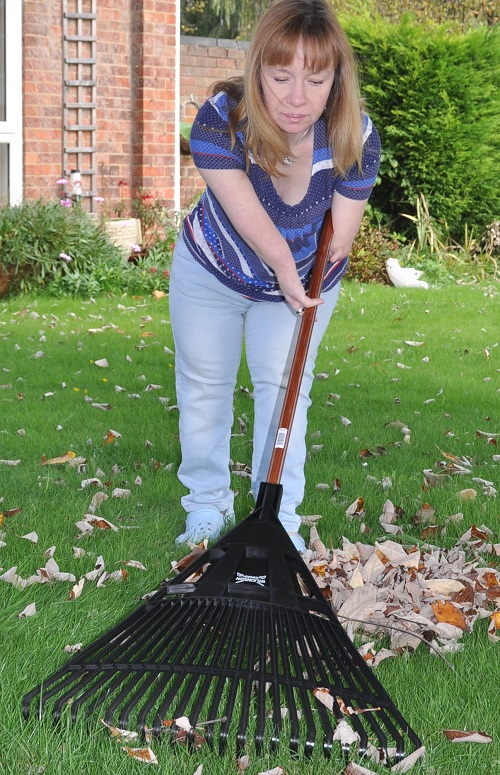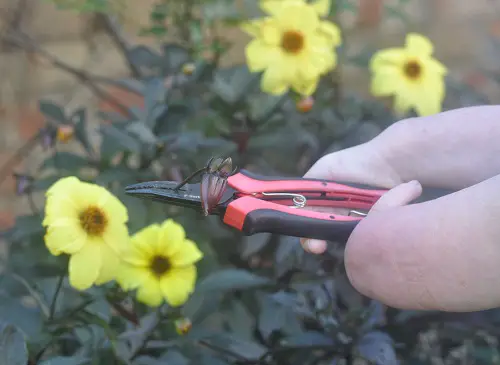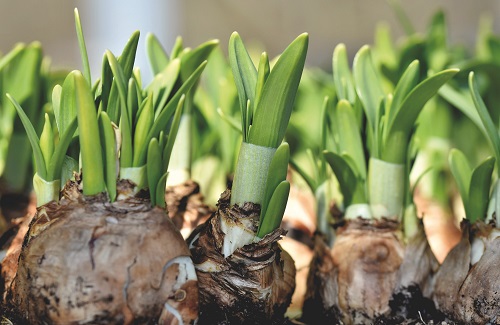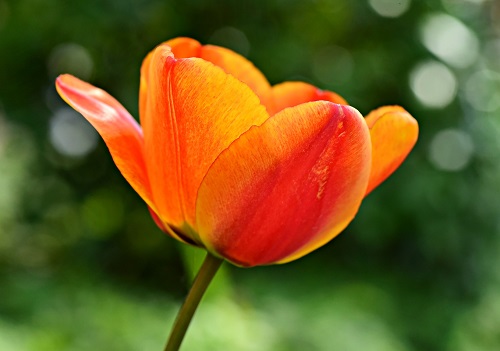
Gardening jobs for autumn: top tips if you’re disabled
Niki Preston, who has phocomelia and secondary thalidomide, is a keen gardener. She talks about her experiences as a disabled gardener on her blog. Here, she shares tips for gardening in autumn if you have a disability.
You might assume that this time of year is the end of your garden year. I don’t believe that at all. There are so many jobs still to do out there to prepare it for frost, spring next year, and to keep your garden looking interesting through the winter.
Gardening if you’re disabled
Sometimes gardening can all feel a little overwhelming, especially if you are disabled, have less mobility or just don’t really know what to do now. Hopefully, I can help allay some of those feelings and encourage you out there, even for a quick tidy up.
I am a disabled gardener, known as The Two Fingered Gardener and have been writing about my experience as a disabled gardener for more than seven years.

My garden consists wholly of raised beds ranging from four feet high to those I can sit and stand at. I have also been very lucky to have been able to try and test many hundreds of garden products.
So, I am hoping that if there’s something you need I have probably tested it and will be able to point you in the right direction.
Try the Peta Easi-Grip arm support gardening cuff, garden trowel and cultivator, all available on the Disability Horizons Shop.
Gardening jobs for autumn
Make leaf mulch
One of my favourite jobs at this time of year is making leaf mulch. Leaf mulch is great for surrounding your perennials to give them added protection, reduce weeds and help retain water. It is relatively easy to do as well.
As the leaves start dropping, rake them up into a few piles. I have a lightweight rake that I can use even sitting down.
Once you have your piles of leaves, bag them up into black bin bags, tie a knot in your filled bag. Then poke several holes into the bag and store in a corner of your garden somewhere.
Within a year you will have a lovely lot of your own leaf mulch. An easy peasy quick job with big rewards later on.
Add some colour to your garden
A great plant for colour this late in the season is dahlias. Mine are all still looking marvellous right now. It has been a great year for dahlia. If you keep on top of regular dead heading they will reward you with flowers for several weeks yet.
A really handy pair of secateurs to have if you struggle to hold the deadheads is a pair called Cut ‘n’ Hold by Darlac.

They are so handy because, as the name suggests, you cut the dead bloom and they hold the bit you’ve chopped off! You can then drop it into your trug.
As my dahlias are all in high raised beds, which makes it a slightly warmer environment than the ground, I don’t dig them up to store them over winter – they stay where they are all year round.
So far I have only had a couple of losses. I can live with that for the easy garden life.
If your dahlias will be staying in the ground over winter, wait until the leaves have been blackened by the first frost/cold spell, then chop them down to about an inch above soil level.
Then cover them with mulch for added protection. Leaf mulch is such a great thing to have in your garden.
Plant bulbs for spring

One other job that is quick and easy is planting bulbs. Daffs are particularly good to plant up now. For a natural look, throw them on the area you want and plant them where they land. That way they don’t look to placed or formulaic.
If bulb planting is tricky because of mobility or grip, you can still bring autumn colour indoors — and even prep arrangements for school fairs, weddings or charity events — by ordering bulk, ready-to-arrange stems. Services like WholesaleFlowers carry superior‑quality sunflowers, lilies and hydrangeas with a wide selection and fast turnaround, so you can design bouquets or table displays at a comfortable height on a raised bench. Pair with ergonomic snips and lightweight vases to keep the whole process accessible and low‑effort.
Alternatively, you could create a bulb lasagne. They’re ideal for smaller space and are a fab way to get a pot to flower for months.
Put later flowering bulbs, such as tulips or hyacinths, in the bottom, making sure there is enough compost below.
Then, cover them with a few inches of compost and layer up with something like narcissi (daffodils), muscari (grape hyacinths) or anemone.

I’d suggest making the final layer snowdrops, crocus or miniature iris. As the months go by at the beginning of next year, each layer will flower, giving you colour all spring. It’s as easy as that.
I hope you have found some of these ideas for the autumn garden useful. Happy gardening.
Please do check out my website The Two Fingered Gardener for more ideas and garden tool reviews, and follow me on Twitter @NikiJRP.
By Niki Preston
Accessible Gardening Tips for Autumn
As autumn arrives, many people assume it’s time to hang up their gardening gloves — but that’s far from true. Gardening at this time of year can be productive, relaxing, and accessible for everyone.
1. Use Accessible Gardening Tools
Adaptive tools make all the difference for gardeners with limited dexterity or mobility. Products like the Peta Easi-Grip Arm Support Gardening Cuff can reduce strain, while the Easi-Grip Garden Trowel and Easi-Grip Garden Cultivator are ideal for raised beds and container gardening. These products are available on the Disability Horizons Shop and can make a real difference in comfort and independence.
2. Make Your Own Leaf Mulch
Leaf mulch helps your soil stay healthy through winter. Collect fallen leaves in a few lightweight piles, then bag them in black bin liners with small holes for airflow. Leave them in a shaded area, and within 12 months, you’ll have rich, crumbly mulch ready for use — perfect for protecting perennials and preventing weeds.
3. Add Colour with Late Bloomers
Dahlias and other late-flowering plants can brighten your garden right into November. If you use raised beds, you may be able to keep them outside all winter. Otherwise, cut them back after the first frost and cover with mulch for protection. Lightweight, long-handled tools like the Darlac Cut ‘n’ Hold secateurs help reduce bending and strain.
4. Prepare for Spring with Bulb Layers
Planting spring bulbs now can bring colour in stages when the weather warms. Try creating a ‘bulb lasagne’: tulips or hyacinths at the bottom, daffodils or muscari in the middle, and snowdrops or crocuses at the top. This technique works beautifully in raised containers for easy access.
Expert Insights
According to the Royal Horticultural Society (RHS), even light gardening can support physical and mental wellbeing. Gardening while sitting, pacing yourself, and using tools designed for your needs can improve mobility and confidence. As Niki says, “Gardening is for everyone — it just takes a few tweaks to make it work for you.”
Latest Research
5. The Wellbeing Power of Gardening
The University of Sheffield’s recent research confirms that gardening — even in small, accessible spaces — can reduce anxiety by up to 20% and significantly improve mood. Their study on Green Social Prescribing showed that gardening and nature-based activities enhance wellbeing for thousands of people living with mental health conditions.
Research Highlights
- The University of Sheffield found that nature-based social prescribing improved mental health and happiness in more than 8,000 participants.
- Gardening reduces anxiety by approximately 20%, lowers cortisol levels, and boosts serotonin — helping maintain emotional balance and calm
- Meta-analyses of global studies confirm that gardening reduces depression, anxiety, and stress, while improving life satisfaction and cognitive function (PubMed, NCBI).
- According to the Royal Horticultural Society (RHS), accessible gardening encourages independence, physical activity, and community connection for disabled and older gardeners.
Expert Insight
“Gardening is for everyone — it just takes a few tweaks to make it work for you,” says Niki. Raised beds, adaptive tools, and pacing yourself can transform gardening into an accessible, joyful activity that benefits both body and mind.
.
More on Disability Horizons…